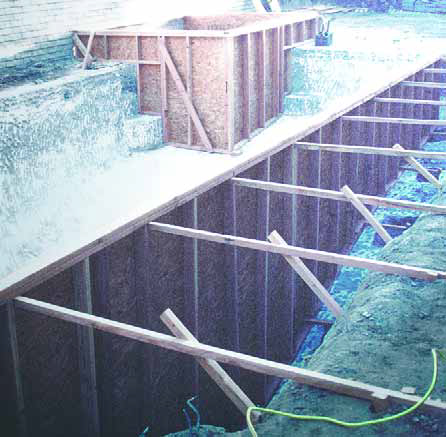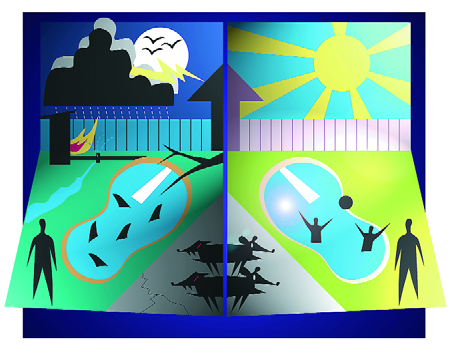construction
Cascades and waterfalls are different from most other types of watershapes. In ponds, for example, the quiet reflective surface of the water serves to accentuate elements within the water, such as the plants, fish and rock materials, while reflecting the features surrounding it. That same reflectivity is a hallmark of pools as well. Our purpose in setting up cascades and waterfalls is, by contrast, to highlight the water itself, and specifically the beauty of water in motion. As it flows over and around rocks and descends through natural weirs and cascades, the water itself creates interest, excitement and soothing sounds. There's also a greater sense of variety when you make the water move. Within relatively small spaces, we set water up to rush and meander, cascade and roll, tumble and trickle - all by way of conjuring impressions of a natural stream moving down a grade. Using moving water in this way - in mimicry of nature - is a true watershaping specialty, and volumes could be written about what it takes to make these scenes believable. For now, however, let's focus on setting up headwaters - a feature we at Xstream Ponds in Cashiers, N.C., have come to see as the key to
Perhaps the hardest thing for a watershaper to accomplish is to take a set of someone else's drawings, plans, sections and elevations, roll them all around together and come up with an accurate, three-dimensional, living interpretation of an architect's vision. The project shown here is a prime example of what's involved in this process. Designed by senior landscape architect Patrick Smith of the Austin, Texas, firm of Richardson Verdoorn, the plans called for three separate streams ranging in length from 50 to 80 feet (with each dropping 36 inches over various weirs) - all converging on a rocky
One of the things I like most about working with water is that it makes statements that don't require much verbal explanation. In fact, I like to think that the projects I build speak volumes about my clients' desire for something creative and interesting. They also speak to the point that most of my clients grant me the freedom to give my very best effort, both aesthetically and technically, without many constraints. Not all the work I do is so modern in style or approach as the project pictured in these pages, but this one illustrates a principle that's become a
Last time, I mentioned initial meetings and discussions having to do with a retrofit project in Pacific Palisades, Calif. I call it a "retrofit" because we're using a portion of an existing pool shell as part of the new one, but in truth this is really a ground-up reworking of the entire environment. This project displays the influence that architects Ricardo Legoretta and Luis Barragan have had on my thinking about shapes, colors and spatial relationships. As soon as I saw this place, in fact, the work of both came to mind because of the strong colors and materials and the expressive
Is it honest to say that too few of the swimming pools you find in America's backyards are what one could call well built - and that even fewer of them are well designed? I think so, because so many of the pools I see run like junk and look like junk, and it's way too easy to find installations that lack any apparent relationship to their settings, their homes' architecture, the landscaping or any recognized
It's not every day you get the chance to work on a project that's going to be seen around the world by millions of people for decades to come. That was exactly the opportunity that came our way in October 1999, when we were asked by the Denver Broncos to construct an elaborate waterfeature at Invesco Field at Mile High, a brand-new stadium that opened at the beginning of the 2001 football season. The project architect - HNTB Sports of Kansas City, Mo. - had developed
A grand California estate deserves a grand pool, and Cima del Mundo is certainly no exception. The new pool is part of a project that involves the complete renovation of a classic estate in the hills of Montecito, a prosperous enclave just south of Santa Barbara, Calif. In keeping with the overall theme of the project, which was described in detail in "The Crest of the World" (WaterShapes, January/February 2001, page 32), the pool has been outfitted with thoroughly
Increasing numbers of our clients are asking for more from their watershapes - so many, in fact, that we're seeing an unprecedented blurring of the lines between swimming pools, spas and the full range of decorative waterfeatures. This demand is particularly strong in one area: In addition to projects that are functional, our clients want them to be visually compelling as well. This need has inspired designers at our firm (and elsewhere) to new levels of creativity. In certain instances, we at Leisure Living Pools in Frisco, Texas, have answered the call with spa designs that
When you work on projects in which stone is commonly measured in the thousands of tons and streams are frequently described in fractions of miles, you're not easily impressed by size. This job, however, was remarkably vast - a project driven by creative passion and a client's desire to turn a singular vision into reality. It's the kind of opportunity that doesn't come along every day, and when it did, we knew we'd have to give it everything we had. Our company, Glacier Inc. of Glenshaw, Pa., is a design and construction firm specializing in large natural and naturalistic bodies of water, and most of our work includes






















